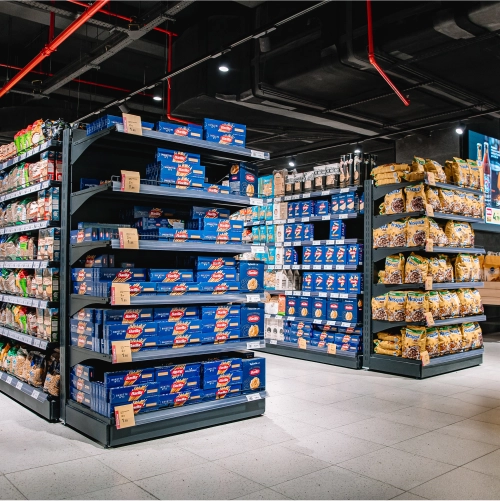Basic merchandising rules
- / Blog
- / Basic merchandising rules
Proper merchandising forms the base of a successful sale in any market, where every department works to attract attention and increase revenue. Merchandising is the process of placing and organizing products in a retail space that influences customer behavior and sales volume through thoughtful layout and visual accents.
The basic rules of merchandising help businesses strengthen their niche position, increase customer loyalty and increase the number of purchases made per visit. The bases of merchandising are built on an understanding of customer psychology, where the right product area determines the success of the entire sale.
Why does a store need merchandising?
The golden rules of merchandising in the store solve everyday business problems, increasing the efficiency of every square meter of retail space and influencing the customer's decision:
- First comes building customer loyalty through easy navigation and pleasing appearance of product shelves. The customer remembers the store, where it is easy to find the right product without unnecessary searches, and comes back for a second purchase.
- Next, advertising plays a role in persuading the shopper to make a spontaneous purchase through brightly colored signage and promotional materials at the entrance or key areas. Signage with information about the promotion attracts the eye and motivates to add the product to the cart.
- Sales of products with impending expiration dates are accelerated by placing them at the front of the shelving or checkout area shelving. This minimizes wastage and maintains a fresh assortment in the department.
- Average check growth is achieved through impulse purchases, when customers see related products and decide to increase the number of items in the check.
It can be concluded that merchandising display rules act as a tool to stimulate additional sales.
The rule of ten steps
Considering the rules and principles of merchandising, it is necessary to mention the so-called rule of 10 steps. It means that after entering the store, the customer passes the initial section of the path, assessing the overall attractiveness of the space and the assortment. These first 10 steps are critical because they form the first impression and set the tone for the entire customer visit.
In this area, place staple products with high turnover, seasonal new products or promotional items to capture attention immediately. Choosing the right layout increases the chance that the customer will pick up the product and put it in the cart at the start of the journey. If the goal is achieved at this stage, further movement through the store will lead to additional purchases, and sales will increase naturally.
The “golden triangle” rule
Also highlighted is the “golden triangle” rule, which focuses on the optimal organization of the retail space for maximum product visibility. Shoppers usually start from the central part of the store, then move to the right wall and only then to the left, forming a natural triangle of movement. The main attractive products are placed in these areas so that they come into the customer's field of vision as soon as they enter. The center zone is ideal for sales hits or new products, the right wall is for high margin categories, and the left wall is for supporting items. This approach increases the chance of impulse buying and helps prioritize the layout.
Movement
The movement of shoppers through the store is predominantly counterclockwise. This pattern is taken into account when planning the layout. In grocery stores, the right side of the entrance is filled with shelving with fresh fruit, vegetables or bread so that customers can immediately see bright and appetizing products.
In clothing stores, new collections, trending models or products under promotion are laid out, attracting the customer's eye to fashionable novelties. The left side remains for everyday categories. Here the customer gets here later, already with a filled basket.
The checkout area completes the route with small impulse products in bags or on separate shelving.
Selling Neighborhood
The selling neighborhood rule emphasizes placing complementary products side-by-side to increase the likelihood of simultaneous purchase and increase the number of items in the receipt. A customer picks up the main product, sees a suitable complementary item nearby, and adds it to the cart without a second thought. To understand this rule, we need to look at a few examples:
- In the grocery store, pasta is next to sauces and spices for a complete dinner set.
- Sugar, creamer, cups and cookies are placed next to coffee.
- In the household chemicals department, cleaning supplies stand next to sponges, gloves and wipes.
- Snacks, limes or glasses are laid out near alcohol.
- In clothing stores, shirts are next to ties, belts and accessories to complete the look.
Price tags to match the type of display
Price tags are adapted to the specific type of product display so that the price information remains accessible and does not distract from the product itself:
- For shoes, plastic price tags are used with lanyards, rings or clips. They are placed on shelves or in a display case without closing the view.
- Meat products require paper price tags with moisture-resistant coating, resistant to cold. They are placed side by side on a shelf or in a refrigerated showcase.
- In grocery, large price and name labels are attached to the front edge of shelving for visibility from afar.
- The checkout area uses compact price tags on chewing gum, batteries or bags.
- For promotions take colorful promotional price tags with a highlighted price and expiration date.
It remains to be added that merchandising increases sales, improves customer experience, creates an attractive retail space and builds loyalty through proper layout and attention to detail.

Нужна консультация?
Отправьте заявку, и мы Вам перезвоним.






